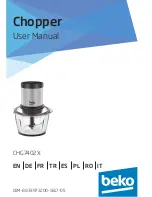
Page 19
IQ-USM 810
IQ Digital Processor / Digital Mixer
IQ-USM 810
Reference Manual
away” from occuring during periods of very low
signal level. Control range is from –100 to +20 in
1
/
2
-dB steps.
•
•
•
•
•
Attack Time:
sets the time required for the Auto-
Leveler to expand its gain by 20dB. Control
range is 0.1 seconds to 60 seconds in 0.1-sec-
ond steps.
•
•
•
•
•
Release Time:
sets the time required for the Auto-
Leveler to compress its gain by 20-dB. Control
range is 0.1 seconds to 60 seconds in 0.1-second
steps.
•
Mode:
When set to “Open to Last Gain” the Gate
opens to the last gain computed by the Auto-Lev-
eler. In “Open to Idle Gain” position, the Gate
opens to a potentially safer “Idle Gain” setting.
Using the “Idle Gain” setting can provide a
smoother transition from “very soft” to “very loud”
input program.
•
Idle Gain:
sets the initial Gate gain when the
Auto-Leveler mode is set to “Open to Idle Gain”.
Control range is from –100 to +20 in
1
/
2
-dB steps.
4.3.5 Input Compressor
The input compressor provides a means for con-
trolling the dynamic range of input signals. It is a
feed-forward type, which performs the compres-
sion after the Input Level Meter. The Input
Compressor’s affect on input gain is metered by
the Input Dynamic Cut/Boost Meter (See Section
4.2.2). Seven parameters control this feature:
•
•
•
•
•
On/Off:
turns this feature on or off.
•
•
•
•
•
Compression Ratio:
determines how many dB
the input level must change for a 1-dB change in
output level. Dynamic variations in the input sig-
nal will be reduced by a factor equal to the com-
pression ratio. Control range is 2:1 to 32:1.
•
•
•
•
•
Threshold:
specifies the average signal level (af-
ter side-chain processing) above which the com-
pressor will begin to reduce gain. Control range is
from –80 to +20 in 1-dB steps.
•
•
•
•
•
Attack Time:
sets the time required for the Com-
pressor to decrease its gain by 20 dB. Control
range is from 1.0 milliseconds to 100 milliseconds
in 1-millisecond increments.
•
•
•
•
•
Release Time:
sets the time required for the Com-
pressor to increase its gain by 20 dB. Control
range is from 0.1 to 10 seconds in 10 millisecond
increments.
•
Delay:
each of the A/B Processing Sections have
an additional delay function. Since the Input Gate
sense is before the delay, a delay at this point al-
lows the gate to act before the signal actually ar-
rives. This gives the gate the opportunity to react
early, allowing initial syllables in speech to not be
missed by gate reaction time. Delay is displayed
in IQ for Windows software in time, feet, and
meters. Control range is from 0 to 10 milliseconds
in 20 microsecond steps.
•
Attack Time:
sets the time required for the Input
Gate to increase its gain by 20 dB. Control range
is from 0.2 milliseconds to 100 milliseconds in
0.01-millisecond steps.
•
Hold Time:
determines how long the Input Gate
will remain open after the control key signal falls
below the Threshold. Control range is from .01
seconds to 10 seconds in 0.01-second steps.
•
Release Time:
sets the time required for the In-
put Gate to decrease its gain by 20 dB. Control
range is from .01 seconds to 10 seconds in 0.01-
second steps.
NOTE:
NOTE:
NOTE:
NOTE:
NOTE: All inputs being used with the Duck Priority func-
tion must have their individual Gates set up. If the Gates
are not set up and turned on, Duck Priority will not work.
4.3.4 Auto-Leveler
The Auto-Leveler works in tandem with the Input
Gate to compensate for long-term average input
levels that vary over time. When the Auto-Leveler is
enabled, the open–state gain of the corresponding
Input Gate, normally 0-dB, is adjusted dynamically
to achieve a desired average output level. The Auto-
Leveler’s affect on input gain is metered by the Input
Dynamic Cut/Boost Meter (See section 4.2.2). Eight
parameters control this feature:
•
On/Off:
turns this feature on or off.
•
•
•
•
•
Threshold:
sets the input level below which the
Auto-Leveler action will be inhibited. This allows
the Auto-Leveler to suspend gain changes during
quiet passages and, along with Max Gain, pre-
vent excessive system gain. Control range is from
–80 to +20 in
1
/
2
-dB steps.
•
•
•
•
•
Target Level:
sets the desired average output
level. The Auto-Leveler will expand input signals
below this level and compress input signals
above this level. Control range is from –100 to
+20 in
1
/
2
-dB steps.
•
Max Gain:
sets the maximum gain through the
Auto-Leveler. This feature can prevent “run-
















































